Is your garden space limited? Learn how to plant a vertical garden to improve your crops and save on space!
It always seems like there is more I want to grow than space to grow it in. I mean have you seen the Baker Creek Seed Catalog? Don’t you just want to grow everything in there?!?
This site contains affiliate links. If you make a purchase using one of these links, I may earn a commission. Please see my disclosure page for more information about cookies collected and our privacy policy.
But there’s only so much space in the garden, so what can you do to fit more?
Grow up! With vertical gardening the sky is the limit, literally! So gather your bamboo, your tomato cages, your twine and let’s grow UP!
How to Use Vertical Gardening in Your Garden (and Why You Should)
I’ve already mentioned one of the major benefits of vertical gardening- it saves space! But it’s not the only reason to grow vertically. Growing up is actually better for the plants too.
Plants that are sprawling on the ground have a higher chance of disease, damage, and pests. With vertical gardening, your plants will:
- Have more air flow around them. Allowing them to dry quicker after rains and watering. This can reduce diseases caused by wetness too!
- Be less susceptible to damage caused by kids, pets, even you. You won’t have to move vines around to see ripening fruits or accidentally step on vines spilling into the walkways.
- Have less damage by pests since you will be able to see and pick off pests better and there are less hiding places for the bugs.
How do you garden vertically? That’s pretty easy actually. It’s just a matter of choosing the right plants and the right supports for those plants.
My Yearly Gardening Planner is perfect for keeping track of everything- from your seed inventory to planting dates to disease and pest problems. Start planning your best garden today!
The Best Crops for Vertical Gardening
Almost any crop can be grown in a more vertical fashion, but vining vegetables are best suited for these techniques. These include:
Peas of any sort- Even peas that say they don’t require staking will benefit from being grown vertically.
Pole beans- Pole beans should always be grown vertically. They do well with twine or other light weight trellis. You can even use corn stalks!
Cucumbers- Cucumbers are best grown vertically. Here’s my article on Ways to Trellis Cucumbers.
Winter and Summer Squash- Even zucchini can be grown vertically, but since the plant grows so fast, you need to keep tying the central stalk to keep it from getting too top heavy.
Tomatoes- To truly grow vertically, tomatoes should be pruned of suckers regularly to keep them to a single, central vine.
Melons- Since melons release their fruits as they ripen, they will need additional support for the fruit. Creating a hammock is the best option.
If you grow all of these types of vegetable on a trellis, you will be freeing up a lot of room at the base of these plants for other low growing veggies- like lettuce or radishes.
Pick up a copy of my Companion Planting Guide and Binder to help you design the perfect garden beds with companion planting in mind. Everything you need to know about companion planting in an easy to read format so you can start companion planting sooner!
How to Support Your Vertical Vegetables
When it comes to support there are a ton of options. For the most part you can get a lot of the supports for free or cheap- all you probably need to buy is some twine for tying veggies to the supports. Here are a couple of my favorite supports in the vertical garden.
Check Out: 9 Gardening Supplies You Can Get for Free
Bamboo Poles: Cut bamboo is what I use most for supporting my vertically grown vegetables. I like to make a teepee out of 4 long poles and then wind twine around it from top to bottom. This is an especially good option for beans, peas, and cucumbers.
Fencing Panels: I use fencing panels attached to the ground with metal t-posts for most all my veggies. These are great for heavier crops like winter squashes. Fencing panels is what I use for the bulk of my tomatoes. If you have heavier vegetables you can try using sturdy cattle panels as support.
Check Out: 5 Ways to Stake Tomatoes
Other Crops: Sometimes companion planting is the best way to easily grow vertically! Try using cornstalks or tall sunflowers to support vining veggies like pole beans and other dry beans.
Twine: Twine will be your best friend for vertical gardening. You can use it with any type of post- bamboo, metal, fallen limbs, etc. You can dangle strings from an A-frame for peas and beans. You can wrap rows of twine between 2 vertical posts to act as a fence. It’s an easy and cheap way to create a trellis for your plants.
Tips for Successful Vertical Gardening
Most crops- like peas and pole beans- will grow vertically naturally without a lot of help from you. Certain crops will require your help to get them growing in the right direction.
Crops like cucumbers and squash do have tendrils that will grab onto a trellis, but because of the weight of the vines and fruit, you might need to tie up the stems as they grow.
Eventually they may start weaving in and out of the fencing/support on their own, but until then you will need to help them out, so be sure to check and tie new growth at least once a week.
Once the plant begins to bear fruit, you will need to check the fruits for proper growth and supports as they ripen. Melons in particular will need support in the form of a hammock or the stems will snap from weight.
I have never needed to support squash on a trellis. Even very large Candy Roaster squash grew just fine.
I have had some squashes grow in the middle of a fence which made harvesting near impossible, so check your fruits as they grow so you can make sure none of them get stuck in your trellis!
How to Get Started Planting a Vertical Garden
Step 1: Choose your crop
Step 2: Choose a suitable support for that crop
Step 3: Prune, train, or tie the crop to the support as needed.
It may sound simplistic, but that’s all there really is to growing a vertical garden.
Sure you can get fancy, and grow vegetables and herbs on a wall or strawberries in a tower of gutters, but when it comes down to it, even the most fancy vertical gardens will boil down to these 3 basic steps.
And think, now that your cucumber and squash vines aren’t taking over all the space you can grow even more! What will you do with all that space on the ground?

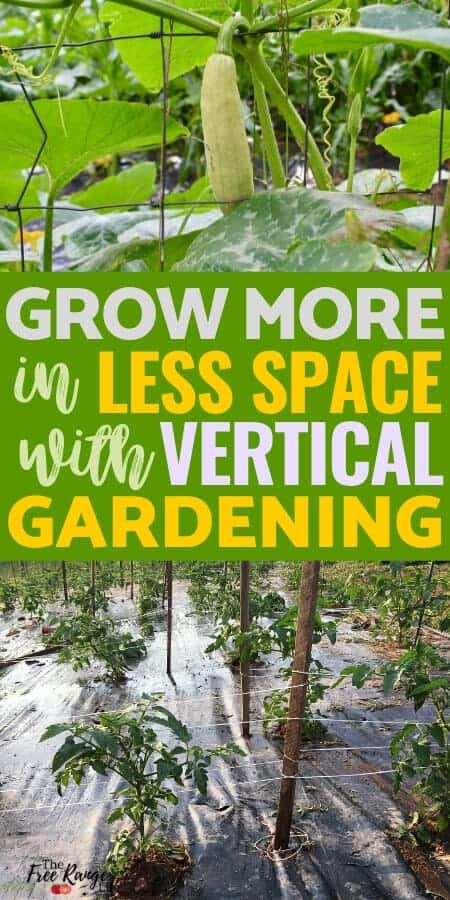
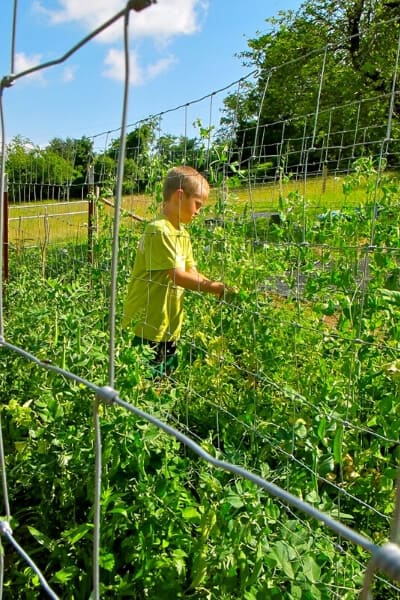
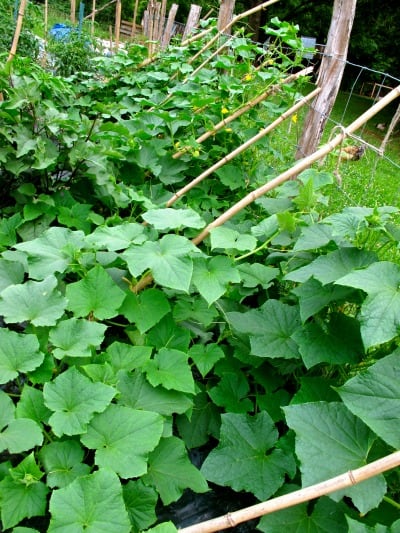
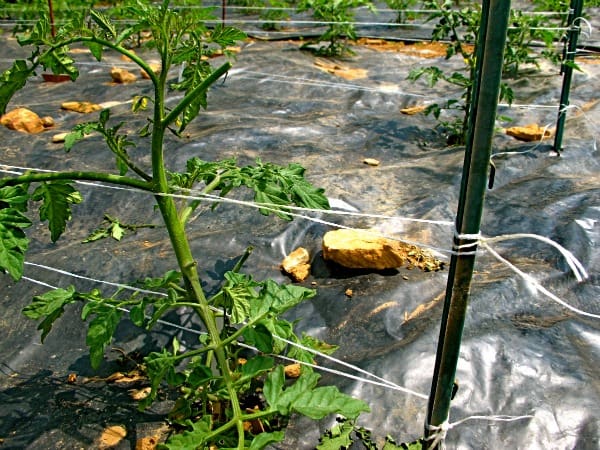

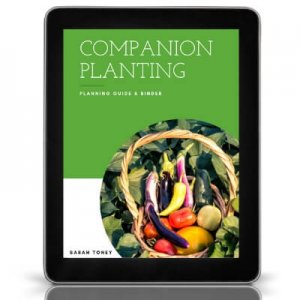
Useful information that’s great for sharing. :) Which I did. It’s funny – when we moved onto a large property, all of that space felt absolutely overwhelming. I’m much more excited now that we’re on a 1/2 acre. No more walking for miiiiiiiles to reach my plants.
Vertical gardening is really an interesting idea, I have only less gardening space and when I was surfing the net for the alternate ideas, I saw the vertical gardening concept and found it interesting, checked it in detail and adopted the gardening technique for my garden.
Never tried to grow squash vertically, but cucumbers we always have. For us they grow without the need for tying at all. Maybe it’s the variety that makes the difference. We grow Straight Eight heirlooms. I would like to try the vertical squash. I could use some help with them!
I know this post is old, but for anyone wanting to grow squash vertically I have found smaller varieties like acorn have grown fine without fruit support, but anything larger, like butternut or Hubbard, definitely needed support
I have grown large butternut varieties and candy roasters vertically without using any sort of support.